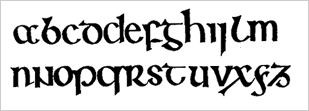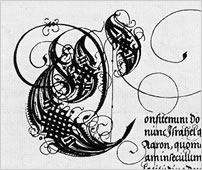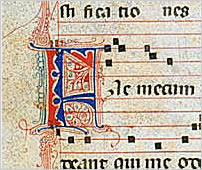| Graphic
Design in History |
Alphabet
and type developments |
|
|
|
|
| |
| |
|
The Irish Celts inherited the Celtic art
of La Tene with large collection of wonderful
ornamental swirling spirals which were used
in Irish, English and Scottish manuscripts.
The main script used was an early formation
of Insular Script, today called Majuscule
(meaning Capital Letter). The place of origin
of the script is often disputed but the
first beginnings were in Ireland.
|
| |
 |
| The Irish Majuscule
has a crucial importance in the
European history of lettering
as the word - Incipit script -
was taken from Latin language,
meaning - ‘here
begins’ and used mainly
for formal purposes as by the
chancery.
Below is an example of the script
used in 'The Book of Kells'. The
same script sometimes was used
as lowercase called Minuscule. |
|
| Irish
Script used in The Book of Kell’s,
AD 800, Trinity College, Dublin
[examples]
|
|
| |
|
8th-9th century Carolingian
Emperor (relating to a dynasty of Frankish
Kings, called Charlemagne - the first sovereign
of the Christian Empire) introduced the
feudal system to bring order to medieval
society and ordered revival of arts based
on the classical Roman past. Charlemagne
recruited Alcum
of York (732-804)
as the "Master of the Palace
School" in Aachen where the foundations
of scholastic theology and philosophy were
laid on "liberal studies and the holy
word" otherwise known as the 'seven
liberal arts'. Many scribers started preparing
copies of religious books using Carolingian
Minuscule (835-1200),
[b], a small cursive type, easy and
quick to write with, and words were set
apart within a sentence with punctuation
marks, which was a new reform within page
layout during this period. The books were
then distributed through Europe by monks,
pilgrims and travellers to spread the idea
of reform and revival through Europe.
|
| |
 |
<
example of Carolingian Minuscule |
| |
| The death of Charlemagne
king resulted in division of the Carolingian
Empire and eventually the imperial title was
passed on to the Romanized Ottoman Dynasty
(Germanic) to carry on with the European reforms
"in
the manner of the Roman". |
| |
| The
governing powers was in
the hands of regional Kings still battling
for their territory as in England The Battle
of Hastings recorded in ‘Doomesday’
book, but eventually European
kings reach for more diplomatic
approach to solve their problems with respect
to the Catholic Church point of view which
concluded on dynamic transformation
in trade, commerce, travel, magnificent architecture,
education, art, science and literature written
in Latin and for the first time in the vernacular
languages.
|
| |
| New medieval
monasteries were building as complexes
comprising of chapels, cloisters, libraries,
workshops, kitchens, refectories, and dormitories
for the monks and to accommodate the monastic
reforms in education. Monastic scriptoriums
begun translations of Holy Bible (a “library
of books”), and classical text in to
Latin (before Vulgate)
and to vernacular languages. New books production
techniques were used as foliation, ruling,
rubrication performed by professional laymen,
text writers, correctors, miniaturists, binders,
book illuminators and other professional which
were call upon as needed and were involved
with the book trade guilds. |
| |
| Writing
was not an independent key of expression as
artists at Winchester
School believed that their paintings and
drawings were more important, but the lettering
had to be varied and original, often used
together in compositions as historiated
initials as in picture Bible. |
| |
|
| Romanesque
period excel in architecture and decorative
arts and is characterized by round arches
and vaults of regional styles developed within
multicultural Europe. Lettering inherited
some of the geometric form architecture and
the arts, which become transition into Gothic
of the 12-16 centuries period. |
| |

|
The
Gothic Rounded Capitals were used in variation
with Rubricated
initials and gothic hand minuscule, quite
bulky and difficult to read. |
| <
Gothic Alphabet |
| |
|
The basic Gothic
letter was a combination of the Carolingian
script and book-hand used through Middle
Ages in manuscripts writing with decorative
combination of capitals, borders and miniature
illustrations even when writing music script.
In time the Gothic script was transformed
in to more narrow and angular with short
ascenders and descends referred to as Textura
|
| |
| In the thirteen
century the demand for books grew together
with wider education and new universities
and the type designers were experimenting
and producing variations of the gothic script
like the Arioso,
Lombardic, Rotunda, Broken Gothic and eventually
the Old English BlackLetter. |
| |
 |
 |
|
Gothic Lombardic script |
Rotunda, Gothic music script |
 |
 |
|
Old Gothic script |
Contemporary Gothic script |
|
| Both the Old Gothic
and the Contemporary Gothic were introduced
in the early 18nth century. |
| |
| The evolution in
constructing the perfect letter types that
we use today was experimented by all Europeans
and many engravers and type founders based
their designs on the Roman, Greek, Carolingian
or Gothic letter type well balanced aesthetically,
and perfect with proportions of height, width,
line contrast and standard spacing between
the letters. |
| |
| Monasteries increased
the volume of books
production and established themselves as book
centres and book collectors undertaking commissions
for commercial shops, guilds, universities
and for the growing educated
aristocratic society. |
| |
|
During late Middle Ages and early Renaissance
of 1348, European countries experienced
one of the worst natural disasters known
as Black
Death or Black Plague, initially called
the "Great Mortality" by contemporary
writers in Europe. The plaque effected generations
until 1700s, killing two-thirds of Europe's
population and creating economic hardship
and depression affecting everyone. The church
suffered most by losing educated scholars
to the epidemic from which situation they
never recovered again and spiritual unrest
within the European population led to dissolution
of the medieval world and new Protestant
reformation laid the foundations for modern
age which started with the Renaissance
Humanistic movement.
|
| |
| Humanism was an
intellectual, literary and cultural movement
which spread through Western Europe during
14th and 15th centuries that signified break
with medieval traditions having its own believes
as the quote below: |
| |
| Quote |
| '..believed
that the liberal arts (art,
music, grammar, rhetoric,
oratory, history, poetry,
using classical texts, and
the studies of all of the
above) should be practiced
by all levels of "richness".
They also approved of self,
human worth and individual
dignity.' |
| |
| Source
Wikipedia
Renaissance Humanism |
|
|
| The classical text
and writings on scientific matters,
government, rhetoric, philosophy
and art were found in the scriptoria
of medieval monasteries which
were used within education as
engagement of theoretical and
philosophical thought, producing
free and civilized human beings,
as bankers, merchants, teachers
and trades people of arts and
crafts. |
In Florence around
1420 a linear perspective was
scientifically understood, which
made it possible to represent
three-dimensional
space on a flat surface and in
lettering the Gothic script was
replaced with the Humanist classic
based on Carolingian style. |
|
|
| |
 |
The
Humanist book- hand had been introduced with
new Capital letters in calligraphic style
imitating handwriting as showed in the picture
below. |
| <
Humanist Alphabet |
| |
| The biggest technological
invention of this period which had a huge
impact on developments in single alphabet
typeface
design was the invention of reliable, moveable
cast type by Johannes
Gutenberg (1398-1468)
in 1455 and his first printed book was the
42
line Bible in 1456. Today Gutenberg is
regarded as the most important figure in Graphic
Design - a 'Grandfather and King of printing'. |
| |
| The printed word
escalated around Europe from the hand written
to the mechanical printing
presses. The engravers, calligrapher's
and printers create new typefaces for the
new presses and for posters in advertising.
It was difficult to cast typeface for mechanical
printing bigger than 96 points, some large
poster typeface had to be set and cut in woodblock
and printed using the old method of relief
printing. |
| |
|
Two printers Conrad
Swenyheym and Arnold
Pannartz [bio]
from Germany brought Guthenberg printing
invention to Italy by setting printing press
in Subiaco,
in 1464. For the first time in print the
Roman type was (sometimes also called “Subiaco
type” or "gotico-antiqua.")
used and their book/incunabula:the
philosophical-ethical work, the “Lattanzio”
and 'Cicero's
De oratore' dated October 29, 1465 was
the first ever printed book in Italy.
|
| |
|
The first cursive or rather italic type
was invented by the Italian Aldine
Press (1494-
1597) known for intensive reproduction
of the classical Roman and Greek text for
leisure reads (incunabula),
owned by Venetian family printer and great
scholar Aldus
Manutius (1449
- 1515) (later
managed by his son and grandson)
who patented the script in early 15nth century
commonly known as Aldine-French old style
(picture below).
|
| |
 |
<
Aldo Manutius Alphabet |
|
|
| The
typeface was designed by Francesco
Griffo (1450-1518) who was responsible
for all mechanical printing at the Aldine
press and who also designed typeface - Bembo
- used by Italian Cardinal Pietro de Bembo
in his book, 'Pietro Bembo's De Aetna', published
in 1495-96. |
| |
| Aldus
Manutius invented and printed first pocket-sized
book (called Octavo)
using the Aldine-French old style script (above)
as it had narrow and compact letterforms which
fitted perfectly into the smaller books. |
| |
| Other Italian type
designers and printers that should be mentioned
are - Giambattista
Bodonii (1740
- 1813) - of
Bodoni typeface - sometimes also called the
'King of Printers' who in 1791 redesigned
the traditional Old Roman type based on the
mathematical and geometric calculations. He
also was the director of the fine press and
publishing house of the Duke of Parma in Italy
where he published his ‘Manuale
Tipografico’ in 1818. |
| |
| During 15nth -
16nth century, it become popular to collect
books written by known scholars and poets
of the classical periods and on philosophy,
science, astronomy, nature, historical books
and bibliophiles which trend initiated creating
archives and personal libraries within growing
aristocratic and middle class households. |
| |
| As
type design evolved around book production,
most developments that took place next were
in perfecting this new technology achieving
excellence in printing, establishing best
type to be used for future publishing needs
and finding adequate solution for printing
illustrations and images within books. A chronological
outline of the most important events can be
found in 'History
of the Book'. |
| continue
.... > type
design |
|
|
|
| |
|
|